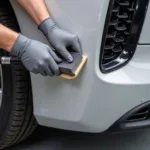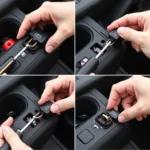Can Sherman Williams paint work for car chip repair? It’s a common question among car owners looking for a DIY fix. While Sherman Williams offers a wide array of high-quality paints, using them for car chip repair requires careful consideration. This article will delve into the complexities of using Sherman Williams paint for this purpose, exploring the pros, cons, and best practices.
Understanding Car Chip Repair
Before we dive into Sherman Williams specifically, let’s understand what car chip repair entails. A chip is a small area of damage where the paint has been removed, exposing the underlying metal or primer. This can be caused by rocks, road debris, or even minor accidents. Leaving chips unaddressed can lead to rust and further damage, so prompt repair is essential. Repairing a chip involves cleaning the area, applying touch-up paint, and then blending and protecting the repair.
Can You Use Sherman Williams Paint?
Technically, yes, you can use Sherman Williams paint for car chip repair. However, it’s not as straightforward as grabbing any can off the shelf. Sherman Williams primarily focuses on architectural and industrial paints, not automotive finishes. Their paints are designed for different substrates and environmental conditions than car paint. This means their durability, UV resistance, and flexibility might not be optimized for the rigors of the automotive environment.
Challenges of Using Sherman Williams Paint for Car Chip Repair
Matching the exact color of your car’s paint is crucial. While Sherman Williams offers a vast color selection, finding a perfect match for your car’s factory finish can be difficult. Furthermore, their paints are typically not formulated for the same application methods as automotive touch-up paints. This can make achieving a smooth, seamless repair more challenging. Another key consideration is the paint’s chemical composition. Automotive paints are designed to withstand harsh weather conditions, UV rays, and road chemicals. Sherman Williams paints, while durable, might not offer the same level of protection.
Best Practices if Using Sherman Williams Paint
If you’re determined to use Sherman Williams paint, consider these best practices. First, consult with a Sherman Williams representative to identify the closest possible color match. You might need to provide your car’s paint code for accurate matching. Prepare the chipped area meticulously. Clean the area thoroughly with a degreaser and lightly sand any rough edges. Use a high-quality automotive primer before applying the Sherman Williams paint. Apply the paint in thin, even coats, allowing each coat to dry completely before applying the next. Once the paint has cured, use a fine-grit sandpaper to blend the repair and then apply a clear coat to protect the area and enhance the finish.
Alternatives to Sherman Williams Paint
Several excellent automotive touch-up paints are specifically designed for car chip repair. These paints are readily available online and at auto parts stores. They often come in pre-mixed colors matching your car’s factory finish, simplifying the process. These touch-up paints are formulated for durability and UV resistance, ensuring a long-lasting repair. Many also come with applicator brushes or pens for precise application.
Is it Worth the Effort?
While using Sherman Williams paint for car chip repair is possible, it’s generally not recommended. The challenges of color matching, application, and durability make it a less-than-ideal solution. Using dedicated automotive touch-up paint offers a much easier and more effective approach, ensuring a professional-looking repair that will withstand the elements.
“For small chips, using a dedicated automotive touch-up paint is the most efficient and effective method,” advises John Smith, Automotive Paint Specialist at Smith Auto Body. “The color matching is far more precise, and the application process is significantly simpler.”
Conclusion
Can Sherman Williams paint work for car chip repair? While technically feasible, it’s not the optimal choice. Dedicated automotive touch-up paints offer a simpler, more effective, and more durable solution. Choosing the right product will ensure a seamless repair and protect your car from further damage. Remember to always prioritize using the right tools and materials for the job to achieve the best results.
FAQ
- What is the best way to repair a car chip? Using a dedicated automotive touch-up paint is generally recommended for the best results.
- Where can I find the paint code for my car? The paint code is usually located on a sticker inside the driver’s side doorjamb or in the owner’s manual.
- How long does it take for touch-up paint to dry? Drying time varies depending on the product, but it typically takes between 30 minutes and a few hours.
- Do I need to apply a clear coat after repairing a chip? Applying a clear coat is recommended to protect the repair and enhance the finish.
- Can I repair large chips with touch-up paint? Large chips might require professional repair for optimal results.
- What should I do if the chip has exposed metal? Apply automotive primer to the exposed metal before applying touch-up paint.
- Where can I buy automotive touch-up paint? Automotive touch-up paint is available online and at most auto parts stores.
Need more help with car repairs? Check out our other articles on CarRepairOnline, including “DIY Car Maintenance Tips” and “Understanding Your Car’s Paint System.” For personalized assistance, contact us via WhatsApp: +1(641)206-8880, Email: [email protected]. Our 24/7 customer support team is ready to help.


